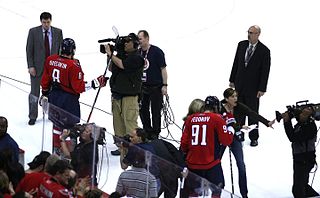United States
In the early days of cable television the Federal Communications Commission refused to regulate it. In 1958 the FCC ruled that cable TV was not a common carrier and thus is not subject to FCC jurisdiction. In 1960 the FCC lobbied against placing cable TV under its jurisdiction, arguing that the administrative burden is inadequate to low perceived threats of unchecked cable development. In 1965 the FCC changed its stance and imposed must-carry rules, requiring cable providers to carry local free-to-air channels, and banned importation of distant channels that duplicated content available on local free-to-air channels.
In the early 1960s, the Federal Communications Commission implemented "the anti-siphoning rules" pertaining to the availability of theatrical motion pictures for broadcast pay TV. The first trial of the technical and commercial feasibility of this business was in Hartford, Connecticut. The three major broadcast networks and National Association of Theatre Owners convinced the FCC to implement regulations that provided theatrical motion pictures would only be made available for exhibition on pay-TV prior to two years after the initial theatrical release and after 10 years from the initial theatrical release date
This restriction had the effect of banning movies from being distributed via pay TV during an 8-year period. Inasmuch as movies typically derived nearly 100% of their revenues during an 18-month period from initial theatrical release, the availability of such movies were limited to a six-month prior to the second anniversary of their initial theatrical release date.
In the end of the 1960s the public and the government raised concerns that cable operators can outbid free-to-air channels and "siphon" popular content, first of all sports, off the free air. [14] Specific events like the Super Bowl were deemed particularly vulnerable due to greater inelasticity of demand. [15]
In 1975 the FCC imposed anti-siphoning regulations that limited the operations of sports and film channels. Under the regulations, cable channels could not devote more than 90% of their time to film and sports, and could not broadcast films less than three years old. Specific (i.e. annual) sporting events could not be "siphoned off" by cable at all if they had been broadcast on free airwaves during any of the previous five years. [15] Cable coverage of regular season games in popular championships was limited so that only a fraction of all games could be shown on cable. [15] Should sports coverage on free-to-air channels decrease, stipulated the FCC, cable operators had to decrease their sports programming proportionately. [15] Administrative record, however, did not support FCC allegations of "siphoning". [16] [ clarification needed ]
The Department of Justice and a number of cable providers contested the FCC ruling in courts as unconstitutional. [15] In 1977 the DC Circuit Court consolidated these cases in Home Box Office vs. FCC and found that the FCC trespassed over the rights guaranteed by the First Amendment. The court ruled that cable bandwidth, unlike broadcast spectra, is not a scarce resource, thus it is not subject to limitations allowed by the Red Lion vs. FCC ruling. The court applied the O'Brien test (the FCC failed two of its four "prongs" [16] ) and found that the degree of limitation of free speech imposed by the FCC was inadequate, "grossly overboard" [16] and thus "arbitrary, capricious and unconstitutional". [15]
In recent years, a growing number of major domestic and international sporting events previously aired by free-to-air channels have migrated to pay-TV outlets. Since 2007, excluding the World Series, Major League Baseball's postseason playoffs have largely moved to cable, while ESPN airs the majority of bowl games of college football (including the College Football Playoff and National Championship, and those owned and operated by its subsidiary ESPN Events). Starting in 2025, all tennis Grand Slams are aired exclusively on pay television -- ESPN with the Australian Open, U. S. Open, and Wimbledon, and TNT with the French Open. [17] [18] The majority of regional broadcasts in major leagues are now shown primarily by regional sports networks (with relatively few or no games broadcast on local free-to-air TV unless it is either nationally televised or only aired over-the-air due to RSN rights conflicts. In 2021, a new television deal between the National Hockey League and Turner Sports will place three of the next seven Stanley Cup Finals exclusively on TNT during odd-numbered years (the others aired in even-numbered years will be aired by ABC). [19] [20] In 2023, Major League Soccer shifted to a streaming-oriented broadcasting model, with all matches streaming on the Apple TV app and MLS Season Pass subscription, leaving a limited linear television package for Fox Sports. [21] [22] [23]
In 2023, the Phoenix Suns became the first team in the NBA to put all regionally televised games on free-to-air, with Gray Television stations in Arizona becoming the primary broadcaster starting in 2023. The Utah Jazz were the second to follow with a new syndication deal with KJZZ-TV and other Sinclair Broadcasting stations in Utah and the Mountain West areas. The Suns' local ratings rose 69% with the move to Gray and Jazz ratings rose 39% with the Sinclair local stations. [24] Meanwhile, the Portland Trail Blazers, which uses an RSN for all games, had ratings crash 60% during the season.
Ratings for the College Football Playoff, the NASCAR Cup Series championship, tennis majors, and PGA's Open Championship have suffered from the siphoning to ESPN. NASCAR's 2015-24 television contract with Comcast's NBCUniversal for NBC and their cable network USA Network during the second half of the season required the broadcast of the championship race to be on NBC, where in previous years it solely aired on ESPN. Likewise, golf's The Open Championship returned to network television in 2016, with weekend coverage on NBC and early round coverage on Golf Channel. Both the Premier League and The Open are unique in that network television coverage is available in the United States, while coverage in their home country (barring highlights) is limited to pay television (which also includes the Comcast-owned pay TV provider Sky).
National Football League
The National Football League implements an anti-siphoning policy as part of its television contracts. The majority of Sunday games are broadcast on over-the-air television by either CBS or Fox in order to reach the largest audience possible, although the games broadcast during the main afternoon windows are determined by the viewer's region, and viewers must purchase the out-of-market sports package NFL Sunday Ticket (which is carried exclusively by YouTube TV) in order to view games that are not shown in their region. Certain flagship games are also broadcast nationally on network television, including NBC's weekly Sunday Night Football , as well as the three annual Thanksgiving Day games, and the entirety of the post-season.
ESPN's Monday Night Football , Amazon Prime Video's Thursday Night Football , as well as selected games exclusively aired by NFL Network, ESPN+, or Peacock, are only televised nationally on pay television or subscription-based streaming . In these cases, NFL rules require simulcasts of the games to be syndicated to television stations within the home markets of the teams that are participating. This ensures that the games are still available on broadcast TV in the local markets, whilst maintaining cable exclusivity for the games outside of the market. Beginning in 2014, ESPN has also held rights to a post-season wild card game; in the first year of this arrangement, the game was only simulcast in the markets of the teams involved, as with its other games. However, in 2015, ESPN began to simulcast the game on ABC (which returned the NFL to the network for the first time since Super Bowl XL) instead. [25] ESPN later gained the right to simulcast selected regular season Monday Night Football games on ABC beginning in 2020, as well as air doubleheaders with simultaneous games split between the two channels. [26] [27]
The Thursday Night Football package previously aired exclusively on NFL Network. The package generated a major controversy in December 2007, due to a Saturday-night game in the package between the New England Patriots and New York Giants, where the Patriots were vying to become the first team since 1972 to have completed the regular season with a perfect record. At the time, NFL Network was not carried by all major television providers (Comcast and Time Warner Cable insisted that they be able to carry NFL Network on a sports tier), and concerns were expressed by critics, such as then Senator John Kerry, that the "historic" game would not be available to the majority of viewers outside of the teams' markets (where the game was to air on WWOR-TV, WCVB-TV, and WMUR-TV) if it were not nationally televised on broadcast television. The NFL compromised by allowing CBS and NBC to simulcast the game, in addition to the three team market stations and NFL Network; commissioner Roger Goodell stated that the decision was "in the best interest of our fans." [28] The arrangement did generate some controversy among broadcasters; WWOR owner Fox Television Stations and WCVB/WMUR owner Hearst-Argyle Television argued that the simulcast devalued what would have been their exclusive local rights. [29]
In 2014, as part of an overall effort to increase the prominence of the Thursday games, several of the games began to be broadcast and co-produced by CBS, in simulcast with NFL Network. [30] In the 2016 and 2017 seasons, this block of games began to be split between CBS and NBC, [31] but moved to Fox in 2018. [32] [33] [34] In the 2022 season, Prime Video assumed exclusive rights to Thursday Night Football; the games can be streamed on Amazon-owned live streaming platform Twitch, and are syndicated to home market stations as per NFL rules for pay television broadcasters. [35] [36]






